Mapping the Structure of Food Waste Management Research: A Co-Keyword Analysis
Abstract
1. Introduction
2. Materials and Methods
- Identification of publications in the selected database of scientific publications (in this case, SCOPUS) based on the adopted criteria (in our case, “food waste” AND “management” until 2019, which resulted in 2202 publications).
- Creating and downloading the bibliographical data of the selected publications from the SCOPUS database in .csv or .ris format.
- Choosing the option in VOSviewer allowing creation of a map based on bibliographical data following the software’s recommendations (i.e., load the data downloaded from SCOPUS, select the option to research keyword cooccurrence).
- Verification of the terms selected by the software, i.e., filtering out “interference” such as general noun words (e.g., “study”, “implications”, “introduction”) and articles (e.g., “the”, “a”, “an”), modal words (e.g., “can”, “will”, “should”), pronouns (e.g., “I”, “we”, “they”), and publishing-related words (e.g., “SCOPUS”, “Palgrave”, “copyright”).
- Generation of a map of keyword relationships and analysis of it using the “items” and “analysis” options.
3. Results and Discussion
- Initial stage (1991–2000)—from the first article regarding food waste management studies published in 1991 to the 2000s, there were few related research results in this field, and the maximum annual number of published papers was only 10 (Scopus database), which means a complete document system had not yet been formed. (The first publication indexed in the WoS database is Wilson and Huang [31]. The first publication indexed in the Scopus database is Eckenfelder [32]).
- Primary stage (2001–2013)—the number of documents in this stage started to rise meaningfully, with an average annual growth of eight articles. It can be considered that the research field of food waste management research was initially formed and growing systematically during this period.
- Fast growing stage (2014–2019)—the number of publications grew annually by 40 articles on average. This indicates that work on food waste management research grew intensively and entered a phase of rapid development.
4. Conclusions
4.1. Limitations of This Study
4.2. Future Research
- The adopted interdisciplinary approach to the analysis of food waste management research, which allowed identification of new research trends (that are marginally indicated in other studies adopting the silo approach, i.e., concentration on a selected management area), can be extended by including investigation of other bibliometric databases (e.g., Web of Science-Clarivate Analytics, EconBiz, EconLit, FSTA—Food Science and Technology Abstracts, and others).
- Expanding the analysis to include, e.g., co-citation and co-authorship relationships, or full-text analysis of papers, would also allow comparison of the results obtained to date in this area.
- Interesting results might also be obtained by conducting analyses using other methods or bibliometric programs.
- In turn, based on the results obtained, we suggest that further research may include future studies focusing on managerial aspects, such as seeking new ways to use the insights of supply chain research instruments and their adaptation to the needs of food waste (which is reflected in most of the identified clusters). Finally, based on this study, future research could use these findings in environmental practice (cities, etc.).
Author Contributions
Funding
Conflicts of Interest
References
- Gustavsson, J.; Cederberg, C.; Sonesson, U.; Van Otterdijk, R.; Meybeck, A. Global Food Losses and Food Waste. Extent. Causes and Prevention; Food and Agriculture Organization of the United Nations: Rome, Italy, 2011. [Google Scholar]
- Monier, V.; Mudgal, S.; Escalon, V.; O’Connor, C.; Gibon, T.; Anderson, G.; Montoux, H. Final Report—Preparatory Study on Food Waste Across EU 27; European Commission BIO Intelligence Service, 2010. Available online: https://ec.europa.eu/environment/eussd/pdf/bio_foodwaste_report.pdf (accessed on 25 July 2017).
- Martin-Rios, C.; Demen-Meier, C.; Gössling, S.; Cornuz, C. Food waste management innovations in the foodservice industry. Waste Manag. 2018, 79, 196–206. [Google Scholar] [CrossRef] [PubMed]
- Parfitt, J.; Barthel, M.; Macnaughton, S. Food waste within food supply chains: Quantification and potential for change to 2050. Philos. Trans. R. Soc. 2010, 365, 3065–3081. [Google Scholar] [CrossRef] [PubMed]
- HLPE. Food Losses and Waste in the Context of Sustainable Food Systems; A Report by the High Level Panel of Experts on Food Security and Nutrition of the Committee on World Food Security; Committee on World Food Security: Rome, Italy, 2014. [Google Scholar]
- The Food and Agriculture Organization (FAO). Food Loss and Food Waste. 2019. Available online: http://www.fao.org/food-loss-and-food-waste/en/ (accessed on 18 January 2020).
- Priefer, C.; Jörissen, J.; Bräutigam, K. Technology Options for Feeding 10 Billion People. Options for Cutting Food Waste Study; Science and Technology Options Assessment: Brussels, Belgium, 2013; p. 2. [Google Scholar]
- Stenmarck, A.; Jensen, C.; Quested, T.; Moates, G. Estimates of European Food Waste Levels; Swedish Environmental Research Institute: Stockholm, Sweden, 2016. [Google Scholar]
- FAO. Global Food Losses and Food Waste. In Extent Causes and Prevention; Swedish Institute for Food Biotechnology (SIK): Gothenburg, Swedenand; FAO: Rome, Italy, 2011; ISBN 978-92-5-107205-9. [Google Scholar]
- Commission Staff Working Document, impact assessment on measures addressing food waste to complete swd (2014). 207 regarding the review of EU waste management targets. Available online: https://ec.europa.eu/environment/archives/eussd/pdf/IA.PDF (accessed on 24 April 2020).
- FAO. Food Wastage Footprint: Full-Cost Accounting, Final Report; FAO: Rome, Italy, 2014; Available online: http://www.fao.org/3/a-i3991e.pdf (accessed on 24 April 2020).
- Rutten, M. The Economic Impacts of (Reducing) Food Waste and Losses: A Graphical Exposition. Available online: https://www.researchgate.net/publication/253240278_WORKING_PAPER_Wageningen_School_of_Social_Sciences_The_Economic_Impacts_of_Reducing_Food_Waste_and_Losses_A_Graphical_Exposition (accessed on 15 November 2019).
- Garnett, T. Food sustainability: Problems, perspectives and solutions. Proc. Nutr. Soc. 2013, 72, 29–39. [Google Scholar] [CrossRef] [PubMed]
- Parry, M.; Parry, M.L.; Canziani, O.; Palutikof, J.; Van der Linden, P.; Hanson, C. Climate Change 2007—Impacts, Adaptation and Vulnerability; Working Group II Contribution to the Fourth Assessment Report of the IPCC; Cambridge University Press: Cambridge, UK, 2007. [Google Scholar]
- Zhao, G.; Liu, S.; Chen, H.; Lopez, C.; Hernandez, J.; Guyon, C.; Iannacone, R.; Calabrese, N.; Panetto, H.; Kacprzyk, J.; et al. Value-chain wide food waste management: A systematic literature review. In Decision Support Systems IX: Main Developments and Future Trends, Proceedings of the 5th International Conference on Decision Support System Technology—ICDSST 2019 & EURO Mini Conference 2019 on “Decision Support System; Main Developments & Future Trends”. Funchal, Portugal, 27–29 May 2019; Abreu Freitas, P.S., Dargam, F., Ribeiro, R., Moreno Jimenez, J.M., Papathanasiou, J., Eds.; Springer: Cham, Switzerlands, 2019; pp. 41–54. [Google Scholar]
- Närvänen, E.; Mesiranta, N.; Mattila, M.; Heikkinen, A. Food Waste Management: Solving the Wicked Problem; Palgrave Macmillan: Cham, Switzerland, 2020. [Google Scholar]
- Lipinski, B.; Hanson, C.; Lomax, J.; Kitinoja, L.; Waite, R.; Searchinger, T. Reducing Food Loss and Waste; World Resources Institute: Washington, DC, USA, 2013; Working Paper; Available online: https://pdf.wri.org/reducing_food_loss_and_waste.pdf (accessed on 24 April 2020).
- Fiore, M.; Pellegrini, G.; Sala, P.L.; Conte, A.; Liu, B. Attitude toward food waste reduction: The case of Italian consumers. Int. J. Glob. Small Bus. 2017, 9, 185–201. [Google Scholar] [CrossRef]
- Fiore, M.; Conte, A.; Conto, F. Retailers towards zero-waste: A walkthrough survey in Italy. Ital. J. Food Sci. 2015, 285, 92–98. [Google Scholar]
- Wilson, N.L.W.; Rickard, B.J.; Saputo, R.; Ho, S.-T. Food waste: The role of date labels, package size, and product category. Food Qual. Prefer. 2017, 55, 35–44. [Google Scholar] [CrossRef]
- Van Herpen, E.; van der Lans, I. A picture says it all? The validity of photograph coding to assess household food waste. Food Qual. Prefer. 2019, 75, 71–77. [Google Scholar] [CrossRef]
- Xin, Z.; Wen, L.Y.; Hai, L.V. Visualization and analysis of mapping knowledge domain of road safety studies. Accid. Anal. Prev. 2018, 118, 131–145. [Google Scholar]
- Ziegler, B.E. Methods for bibliometric analysis of research: Renewable energy case study. Doctoral dissertation, Massachusetts Institute of Technology. 2009. Available online: http://web.mit.edu/smadnick/www/wp/2009-10.pdf (accessed on 18 January 2020).
- van Eck, N.J.; Waltman, L. How to normalize cooccurrence data? An analysis of some well-known similarity measures. J. Assoc. Inf. Sci. Technol. 2009, 60, 1635–1651. [Google Scholar]
- Gudanowska, A.E. A map of current research trends within technology management in the light of selected literature. Manag. Prod. Eng. Rev. 2017, 8, 78–88. [Google Scholar] [CrossRef]
- van Eck, N.J.; Waltman, L. VOSviewer Manual. Manual for VOSviewer version 1.6.11, software documentation. 2019. Available online: https://www.vosviewer.com/documentation/Manual_VOSviewer_1.6.11.pdf (accessed on 24 April 2020).
- van Eck, N.J.; Waltman, L.; Noyons, E.C.M.; Buter, R.K. Automatic term identification for bibliometric mapping. Scientometrics 2010, 82, 581–596. [Google Scholar] [CrossRef] [PubMed]
- Waltman, L.; Van Eck, N.J.; Noyons, E.C. A unified approach to mapping and clustering of bibliometric networks. J. Informetr. 2010, 4, 629–635. [Google Scholar] [CrossRef]
- Van Eck, N.J.; Waltman, L. Visualizing bibliometric networks. In Measuring Scholarly Impact: Methods and Practice; Ding, Y., Rousseau, R., Wolfram, D., Eds.; Springer: Cham, Switzerland, 2019; pp. 285–320. [Google Scholar]
- Eck, N.J.; Waltman, L. Software survey: VOSviewer, a computer program for bibliometric mapping. Scientometrics 2010, 84, 523–538. [Google Scholar] [PubMed]
- Wilson, G.E.; Huang, J.Y.C. Food waste management—2 case studies. Food Eng. 1976, 48, 79–83. [Google Scholar]
- Eckenfelder, W.W., Jr. Food wastes: Unique conditions force treatment decisions. Water Wastes Eng. 1976, 13, 83–87. [Google Scholar]
- Iacovidou, E.; Ohandja, D.-G.; Gronow, J.; Voulvoulis, N. The household use of food waste disposal units as a waste management option: A review. Crit. Rev. Environ. Sci. Technol. 2012, 42, 1485–1508. [Google Scholar] [CrossRef]
- Paritosh, K.; Kushwaha, S.K.; Yadav, M.; Pareek, N.; Chawade, A.; Vivekanand, V. Food Waste to Energy: An Overview of Sustainable Approaches for Food Waste Management and Nutrient Recycling. 2017. Available online: https://www.hindawi.com/journals/bmri/2017/2370927/ (accessed on 24 April 2020).
- Peng, W.; Pivato, A. Sustainable Management of Digestate from the Organic Fraction of Municipal Solid Waste and Food. Waste Under the Concepts of Back to Earth Alternatives and Circular Economy. Waste Biomass Valoriz. 2019, 10, 465–481. [Google Scholar] [CrossRef]
- Ng, B.J.H.; Mao, Y.; Chen, C.-L.; Rajagopal, R.; Wang, J.-Y. Municipal food waste management in Singapore: Practices, challenges and recommendations. J. Mater. Cycles Waste Manag. 2017, 19, 560–569. [Google Scholar] [CrossRef]
- Parry, D. Municipal Food Waste Management Options: Climate and Economic Impacts. In Sowing Seeds in the City; Brown, S., McIvor, K., Hodges Snyder, E., Eds.; Springer: Dordrecht, The Netherlands, 2016; pp. 107–124. [Google Scholar]
- Edwards, J.; Othman, M.; Crossin, E.; Burn, S. Life cycle inventory and mass-balance of municipal food waste management systems: Decision support methods beyond the waste hierarchy. Waste Manag. 2017, 69, 577–591. [Google Scholar] [CrossRef]
- Koido, K.; Takeuchi, H.; Hasegawa, T. Life cycle environmental and economic analysis of regional-scale food-waste biogas production with digestate nutrient management for fig fertilization. J. Clean. Prod. 2018, 190, 552–562. [Google Scholar] [CrossRef]
- Pellegrini, G.; Sillani, S.; Gregori, M.; Spada, A. Household food waste reduction: Italian consumers’ analysis for improving food management. Br. Food J. 2019, 121, 1382–1397. [Google Scholar] [CrossRef]
- Bhatti, S.H.; Saleem, F.; Zakariya, R.; Ahmad, A. The determinants of food waste behavior in young consumers in a developing country. Br. Food J. 2019. [Google Scholar] [CrossRef]
- Loizia, P.; Neofytou, N.; Zorpas, A.A. The concept of circular economy strategy in food waste management for the optimization of energy production through anaerobic digestion. Environ. Sci. Pollut. Res. 2019, 26, 14766–14773. [Google Scholar] [CrossRef] [PubMed]
- Zhao, G.; Liu, S.; Chen, H.; Lopez, C.; Hernandez, J.; Guyon, C.; Iannacone, R.; Calabrese, N.; Panetto, H.; Kacprzyk, J.; et al. Value-Chain Wide Food Waste Management: A Systematic Literature Review. Lect. Notes Bus. Inf. 2019, 348, 41–54. [Google Scholar]
- Nguyen, D.D.; Chang, S.W.; Cha, J.H.; Jeong, S.Y.; Yoon, Y.S.; Lee, S.J.; Tran, M.C.; Ngo, H.H. Dry semi-continuous anaerobic digestion of food waste in the mesophilic and thermophilic modes: New aspects of sustainable management and energy recovery in South Korea. Energy Convers. Manag. 2017, 135, 445–452. [Google Scholar] [CrossRef]
- Singlitico, A.; Dussan, K.; O’Shea, R.; Wall, D.; Goggins, J.; Murphy, J.; Monaghan, R.F.D. Techno-economic optimisation of combined anaerobic digestion and gasification of food waste as part of an integrated waste management and energy system. In Proceedings of the 25th European Biomass Conference and Exhibition, Stockholm, Sweden, 12–15 June 2017; pp. 96–105. [Google Scholar]
- Maalouf, A.; El-Fadel, M. Effect of a food waste disposer policy on solid waste and wastewater management with economic implications of environmental externalities. Waste Manag. 2017, 69, 455–462. [Google Scholar] [CrossRef] [PubMed]
- Becker, A.M.; Yu, K.; Stadler, L.B.; Smith, A.L. Co-management of domestic wastewater and food waste: A life cycle comparison of alternative food waste diversion strategies. Bioresour. Technol. 2017, 223, 131–140. [Google Scholar] [CrossRef]
- Bernstad Saraiva Schott, A.; Wenzel, H.; La Cour Jansen, J. Identification of decisive factors for greenhouse gas emissions in comparative life cycle assessments of food waste management—An analytical review. J. Clean. Prod. 2016, 119, 13–24. [Google Scholar] [CrossRef]
- Bernstad, A.; La Cour Jansen, J. A life cycle approach to the management of household food waste—A Swedish full-scale case study. Waste Manag. 2011, 31, 1879–1896. [Google Scholar] [CrossRef]
- Eriksson, M.; Strid, I.; Hansson, P.-A. Carbon footprint of food waste management options in the waste hierarchy—A Swedish case study. J. Clean. Prod. 2015, 93, 115–125. [Google Scholar] [CrossRef]
- Eriksson, M.; Spångberg, J. Carbon footprint and energy use of food waste management options for fresh fruit and vegetables from supermarkets. Waste Manag. 2017, 60, 786–799. [Google Scholar] [CrossRef] [PubMed]
- Maalouf, A.; El-Fadel, M. Carbon footprint of integrated waste management systems with implications of food waste diversion into the wastewater stream. Resour. Conserv. Recycl. 2018, 133, 263–277. [Google Scholar] [CrossRef]
- Shahariar, S.; Rooney, P. Food waste management options: A case study of Hope Park Campus, Liverpool Hope University, United Kingdom. In Organic Waste: Management Strategies, Environmental Impact and Emerging Regulations. Waste and Waste Management; Nova Science Publishers Inc.: New York, NY, USA, 2017; pp. 1–38. [Google Scholar]
- Salemdeeb, R.; zu Ermgassen, E.K.H.J.; Kim, M.H.; Balmford, A.; Al-Tabbaa, A. Environmental and health impacts of using food waste as animal feed: A comparative analysis of food waste management options. J. Clean. Prod. 2017, 140, 871–880. [Google Scholar] [CrossRef] [PubMed]
- Otles, S.; Despoudi, S.; Bucatariu, C.; Kartal, C. Food waste management, valorization, and sustainability in the food industry. In Food Waste Recovery: Processing Technologies and Industrial Techniques; Academic Press: Cambridge, MA, USA, 2015; pp. 3–23. [Google Scholar]
- Ounsaneha, W.; Suksaroj, T.T.; Rattanapan, C. Choice of food waste management for a large vegetable market in Thailand. Int. J. Environ. Sci. Dev. 2019, 10, 100–103. [Google Scholar] [CrossRef]
- Thamagasorn, M.; Pharino, C. An analysis of food waste from a flight catering business for sustainable food waste management: A case study of halal food production process. J. Clean. Prod. 2019, 228, 845–855. [Google Scholar] [CrossRef]
- Kosseva, M.R. Management and Processing of Food Wastes. Comprehensive Biotechnology, 2nd ed.; Elsevier Inc.: Amsterdam, The Netherlands, 2011; pp. 558–593. [Google Scholar]
- Garcia-Garcia, G.; Woolley, E.; Rahimifard, S. Optimising Industrial Food Waste Management. Procedia Manuf. 2017, 8, 432–439. [Google Scholar] [CrossRef][Green Version]
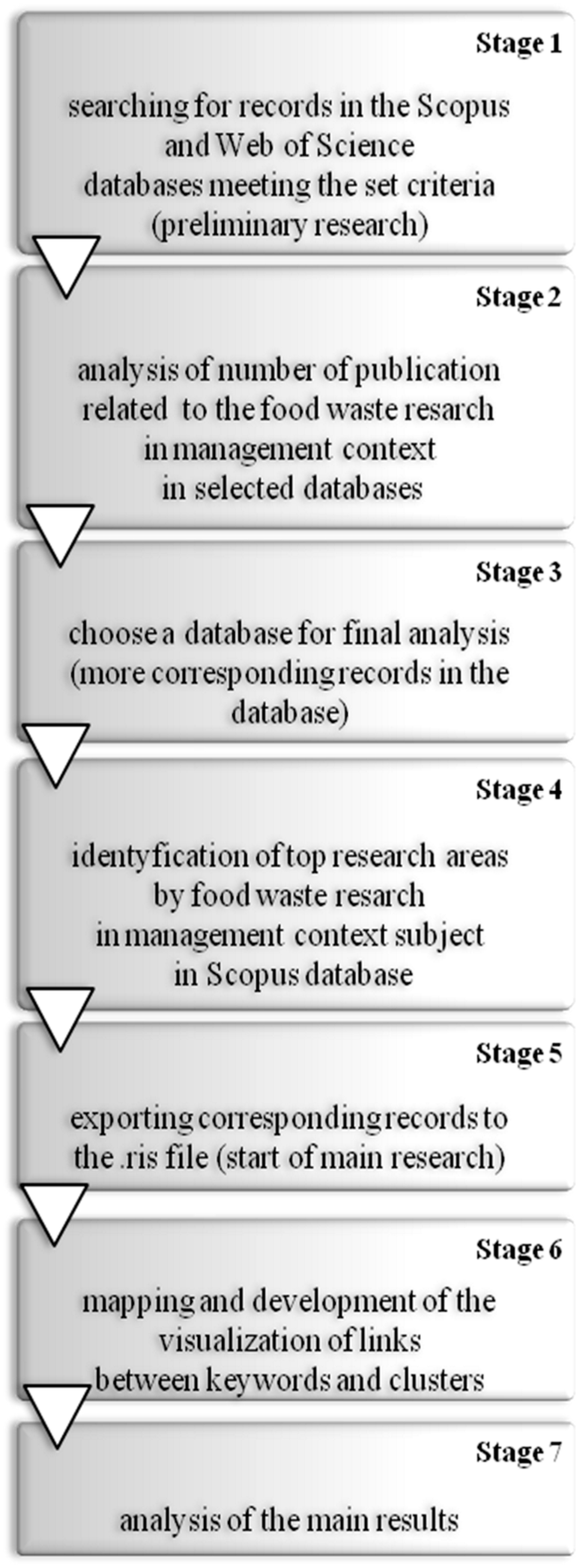
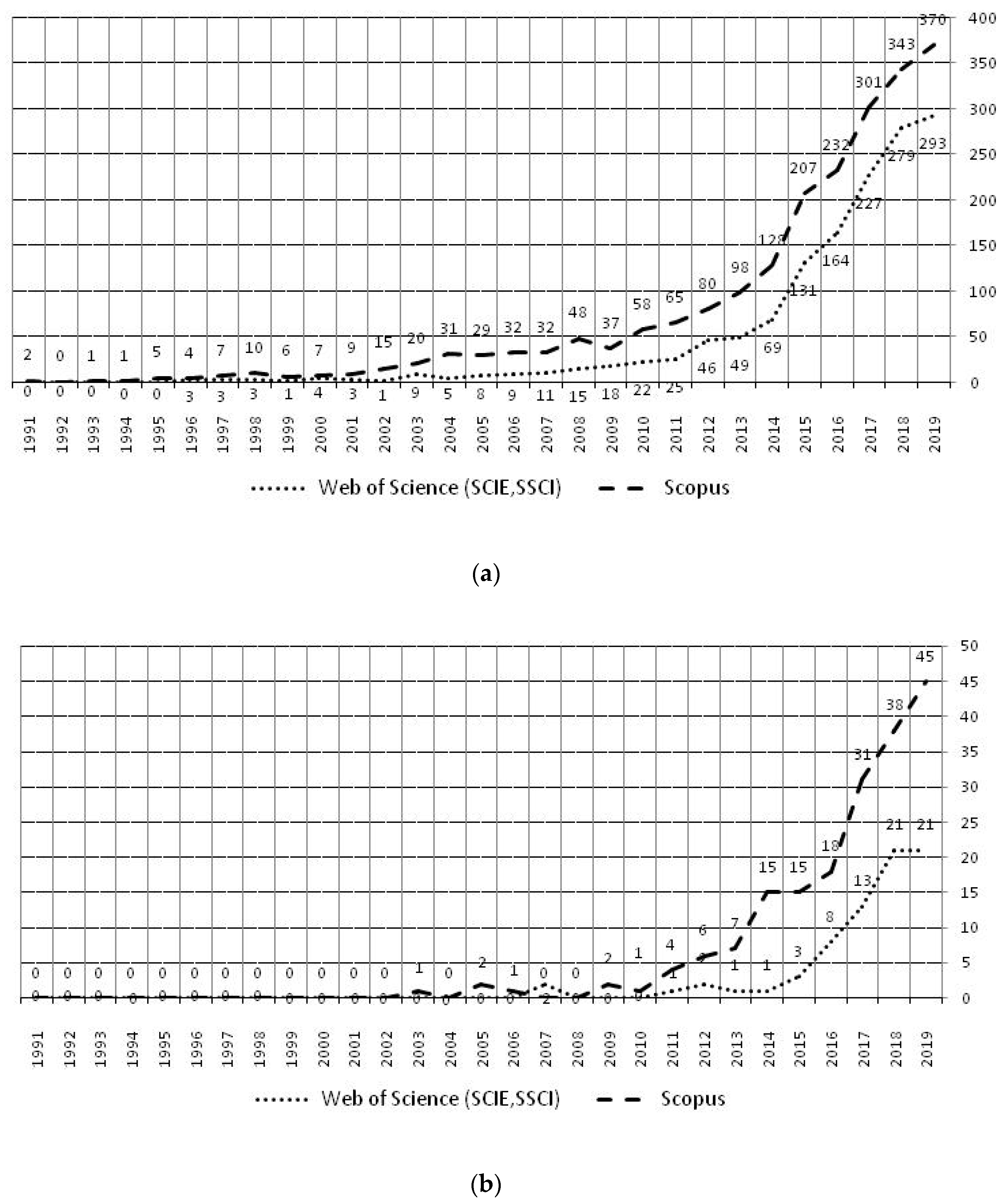
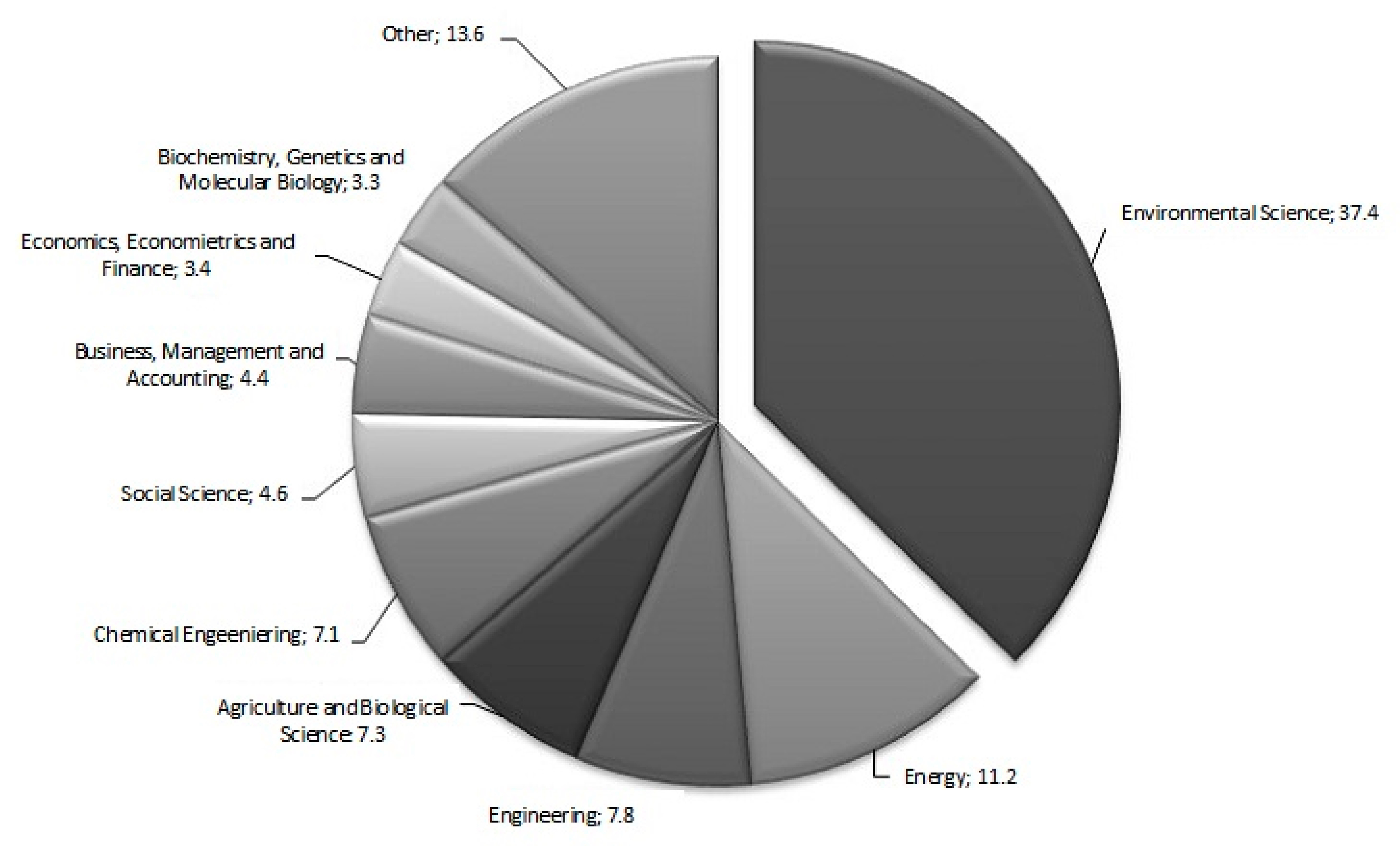
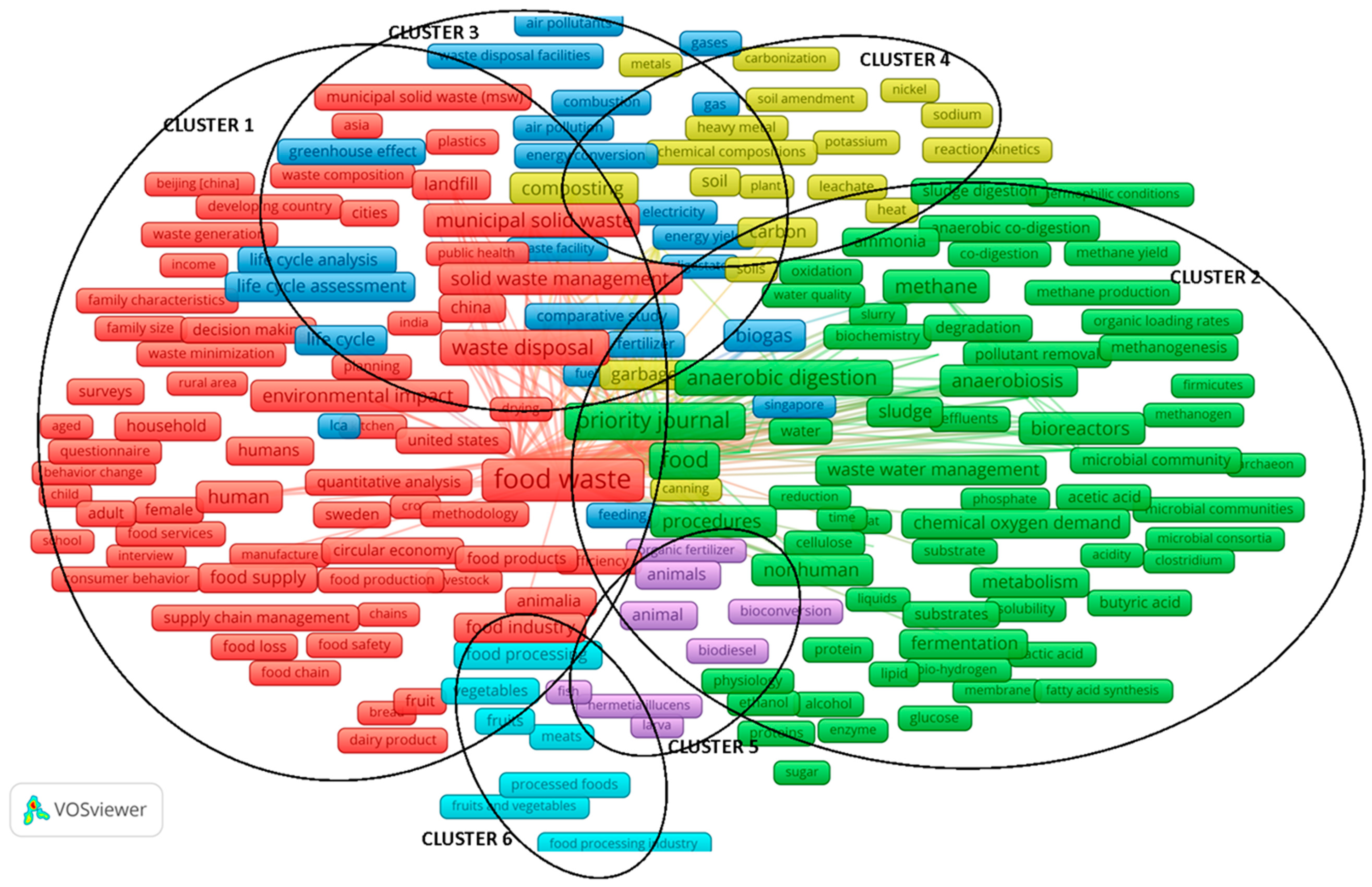
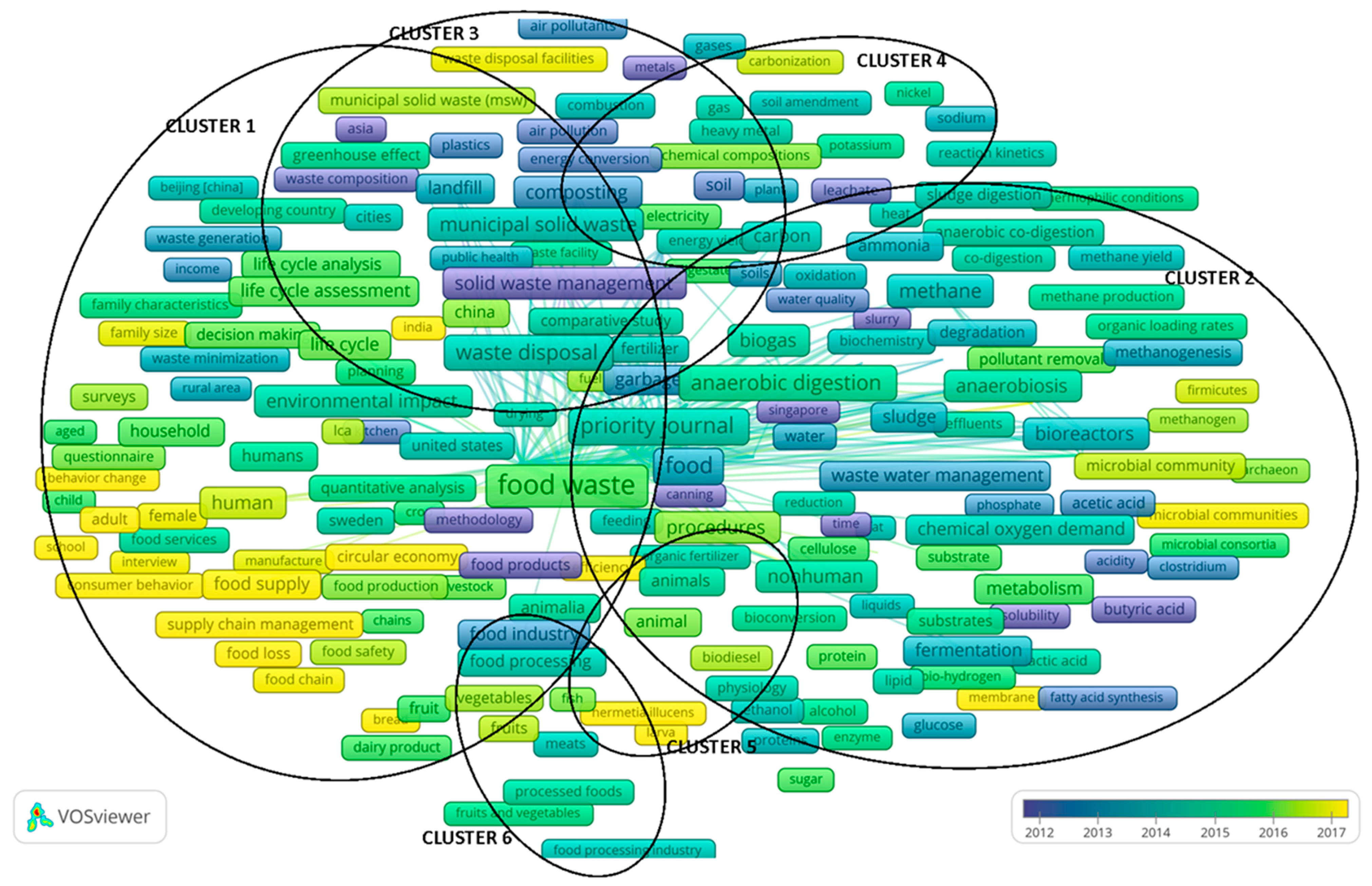
| Cluster | Number of Keywords | Keyword (Max. Co-Occurrence) | Max. Number of Co-Occurrence for Main Keyword | Keyword (Max. Total Link Strength) | Max. Total Link Strength for Main Keyword | Keywords | Co-Occurrences | Total Link Strength |
|---|---|---|---|---|---|---|---|---|
| 1 | 316 | food waste | 1293 | food waste | 26,847 | food waste | 1293 | 26,847 |
| waste management | 1180 | 24,101 | ||||||
| waste disposal | 418 | 10,759 | ||||||
| recycling | 331 | 7249 | ||||||
| municipal solid waste | 304 | 6934 | ||||||
| human | 252 | 5615 | ||||||
| solid waste management | 205 | 5219 | ||||||
| anaerobiosis | 200 | 6941 | ||||||
| landfill | 180 | 4701 | ||||||
| sustainable development | 178 | 2886 | ||||||
| solid wastes | 174 | 3559 | ||||||
| domestic waste | 168 | 4238 | ||||||
| food supply | 158 | 2735 | ||||||
| sustainability | 157 | 2307 | ||||||
| biodegradation | 137 | 3631 | ||||||
| catering service | 117 | 2608 | ||||||
| environmental management | 103 | 2145 | ||||||
| agriculture | 101 | 2233 | ||||||
| carbon footprint | 93 | 2506 | ||||||
| ammonia | 87 | 2745 | ||||||
| animalia | 83 | 1922 | ||||||
| economics | 81 | 1767 | ||||||
| vegetable | 80 | 2329 | ||||||
| compost | 71 | 1527 | ||||||
| chemical composition | 63 | 1853 | ||||||
| acetic acid | 62 | 2064 | ||||||
| fatty acids | 59 | 2040 | ||||||
| biotechnology | 57 | 1631 | ||||||
| supply chain management | 56 | 840 | ||||||
| concentration (composition) | 55 | 1740 | ||||||
| substrates | 54 | 1612 | ||||||
| anaerobic co-digestion | 54 | 1671 | ||||||
| degradation | 52 | 1464 | ||||||
| environmental monitoring | 52 | 1492 | ||||||
| renewable energy | 51 | 1342 | ||||||
| microbiology | 51 | 1690 | ||||||
| adult | 50 | 1043 | ||||||
| butyric acid | 50 | 1651 |
| Cluster | Number of Keywords | Keyword (Max. Co-Occurrence) | Max. Number of Co-Occurrence for Main Keyword | Keyword (Max. Total Link Strength) | Max. Total Link Strength for Main Keyword | Keywords | Co-Occurrences | Total Link Strength |
|---|---|---|---|---|---|---|---|---|
| 2 | 290 | food | 495 | food | 13,706 | food | 495 | 13,706 |
| anaerobic digestion | 465 | 12,000 | ||||||
| methane | 288 | 8615 | ||||||
| controlled study | 281 | 8588 | ||||||
| procedures | 240 | 7744 | ||||||
| nonhuman | 233 | 6820 | ||||||
| bioreactors | 216 | 7174 | ||||||
| environmental impact | 200 | 4491 | ||||||
| sewage | 196 | 6063 | ||||||
| bioreactor | 186 | 6251 | ||||||
| fermentation | 151 | 4245 | ||||||
| ph | 150 | 4744 | ||||||
| nitrogen | 147 | 4414 | ||||||
| life cycle | 145 | 3602 | ||||||
| temperature | 143 | 4096 | ||||||
| waste water management | 139 | 4218 | ||||||
| sludge | 139 | 4479 | ||||||
| food industry | 137 | 3231 | ||||||
| anoxic conditions | 129 | 4457 | ||||||
| metabolism | 121 | 3946 | ||||||
| life cycle assessment | 120 | 3117 | ||||||
| biofuels | 120 | 4027 | ||||||
| wastewater treatment | 115 | 3345 | ||||||
| carbon dioxide | 114 | 3178 | ||||||
| biofuel | 114 | 3743 | ||||||
| volatile fatty acid | 113 | 3892 | ||||||
| hydrolysis | 104 | 3273 | ||||||
| waste products | 98 | 2920 | ||||||
| waste water | 95 | 2950 | ||||||
| biomass | 92 | 2406 | ||||||
| household | 87 | 1878 | ||||||
| waste disposal, fluid | 80 | 2566 | ||||||
| volatile fatty acids | 80 | 2816 | ||||||
| sewage sludge | 77 | 2076 | ||||||
| organic matter | 77 | 2233 | ||||||
| phosphorus | 77 | 2245 | ||||||
| biodegradation, environmental | 77 | 2314 | ||||||
| concentration (parameters) | 77 | 2557 | ||||||
| food wastes | 72 | 1546 | ||||||
| hydrogen | 71 | 2225 | ||||||
| bioremediation | 67 | 1933 | ||||||
| wastewater | 67 | 2025 | ||||||
| fatty acids, volatile | 66 | 2459 | ||||||
| optimization | 65 | 1700 | ||||||
| recovery | 64 | 1531 | ||||||
| microbial community | 64 | 2098 | ||||||
| sludge digestion | 63 | 1907 | ||||||
| hydrogen-ion concentration | 63 | 2183 | ||||||
| environmental protection | 62 | 1390 | ||||||
| acidification | 59 | 2087 | ||||||
| plastic | 57 | 1459 | ||||||
| water | 57 | 1703 | ||||||
| fruit | 55 | 1446 | ||||||
| environment | 54 | 1338 | ||||||
| conservation of natural resources | 54 | 1489 | ||||||
| biodegradability | 54 | 1725 | ||||||
| fertilizer | 53 | 1691 | ||||||
| methanogenesis | 53 | 1836 | ||||||
| municipal solid waste (msw) | 52 | 1062 | ||||||
| waste component removal | 52 | 1701 | ||||||
| cost benefit analysis | 51 | 1244 | ||||||
| manures | 51 | 1461 | ||||||
| quantitative analysis | 50 | 1169 |
| Cluster | Number of Keywords | Keyword (max. Co-Occurrence) | Max. Number of Co-Occurrence for Main Keyword | Keyword (Max. Total Link Strength) | Max. Total Link Strength for Main Keyword | Keywords | Co-Occurrences | Total Link Strength |
|---|---|---|---|---|---|---|---|---|
| 3 | 118 | composting | 254 | composting | 5692 | composting | 254 | 5692 |
| anaerobic growth | 145 | 5139 | ||||||
| chemical oxygen demand | 120 | 4041 | ||||||
| incineration | 119 | 3239 | ||||||
| chemistry | 114 | 3578 | ||||||
| greenhouse gases | 111 | 2739 | ||||||
| life cycle analysis | 107 | 3145 | ||||||
| supply chains | 103 | 1926 | ||||||
| waste incineration | 98 | 2494 | ||||||
| land fill | 93 | 1951 | ||||||
| greenhouse gas | 91 | 2507 | ||||||
| life cycle assessment (lca) | 89 | 2151 | ||||||
| fertilizers | 87 | 2396 | ||||||
| greenhouse effect | 73 | 2311 | ||||||
| gas emissions | 72 | 1851 | ||||||
| manure | 69 | 2040 | ||||||
| moisture | 68 | 1751 | ||||||
| fatty acid | 64 | 2269 | ||||||
| global warming | 63 | 1855 | ||||||
| environmental impact assessment | 61 | 1873 | ||||||
| vegetables | 60 | 1542 | ||||||
| decision making | 59 | 1026 | ||||||
| climate change | 58 | 1283 | ||||||
| leaching | 53 | 1661 | ||||||
| urban area | 51 | 1342 | ||||||
| biofuel production | 51 | 1512 | ||||||
| models, theoretical | 50 | 1522 | ||||||
| composting | 254 | 5692 | ||||||
| anaerobic growth | 145 | 5139 | ||||||
| chemical oxygen demand | 120 | 4041 | ||||||
| incineration | 119 | 3239 | ||||||
| chemistry | 114 | 3578 | ||||||
| greenhouse gases | 111 | 2739 | ||||||
| life cycle analysis | 107 | 3145 | ||||||
| supply chains | 103 | 1926 | ||||||
| waste incineration | 98 | 2494 | ||||||
| land fill | 93 | 1951 | ||||||
| greenhouse gas | 91 | 2507 | ||||||
| life cycle assessment (lca) | 89 | 2151 | ||||||
| fertilizers | 87 | 2396 | ||||||
| greenhouse effect | 73 | 2311 | ||||||
| gas emissions | 72 | 1851 | ||||||
| manure | 69 | 2040 | ||||||
| moisture | 68 | 1751 | ||||||
| fatty acid | 64 | 2269 | ||||||
| global warming | 63 | 1855 | ||||||
| environmental impact assessment | 61 | 1873 | ||||||
| vegetables | 60 | 1542 | ||||||
| decision making | 59 | 1026 | ||||||
| climate change | 58 | 1283 | ||||||
| leaching | 53 | 1661 | ||||||
| urban area | 51 | 1342 | ||||||
| biofuel production | 51 | 1512 | ||||||
| models, theoretical | 50 | 1522 |
| Cluster | Number of Keywords | Keyword (Max. Co-Occurrence) | Max. Number of Co-Occurrence for Main Keyword | Keyword (Max. Total Link Strength) | Max. Total Link Strength for Main Keyword | Keywords | Co-Occurrences | Total Link Strength |
|---|---|---|---|---|---|---|---|---|
| 4 | 116 | waste treatment | 328 | refuse disposal | 8933 | waste treatment | 328 | 8540 |
| solid waste | 302 | 8377 | ||||||
| refuse disposal | 294 | 8933 | ||||||
| waste | 264 | 7290 | ||||||
| biogas | 254 | 6750 | ||||||
| organic waste | 139 | 4011 | ||||||
| carbon | 139 | 4024 | ||||||
| garbage | 127 | 3926 | ||||||
| humans | 108 | 2595 | ||||||
| wastes | 90 | 2016 | ||||||
| soil | 78 | 2187 | ||||||
| food products | 71 | 1264 | ||||||
| energy recovery | 68 | 1940 | ||||||
| cities | 63 | 1822 | ||||||
| comparative study | 60 | 1789 |
| Cluster | Number of Keywords | Keyword (Max. Co-Occurrence) | Max. Number of Co-Occurrence for Main Keyword | Keyword (Max. Total Link Strength) | Max. Total Link Strength for Main Keyword | Keywords | Co-Occurrences | Total Link Strength |
|---|---|---|---|---|---|---|---|---|
| 5 | 30 | animals | 118 | animals | 3271 | animals | 118 | 3271 |
| waste composition | 33 | 687 | ||||||
| chemical water pollutants | 33 | 1056 | ||||||
| heating | 31 | 855 | ||||||
| consumption behavior | 29 | 459 | ||||||
| pollution | 28 | 530 | ||||||
| biological oxygen demand analysis | 25 | 985 | ||||||
| renewable energy resources | 19 | 437 | ||||||
| effluent treatment | 19 | 456 | ||||||
| emission | 18 | 543 | ||||||
| valorisation | 17 | 319 | ||||||
| carboxylic acid | 17 | 507 | ||||||
| microbial diversity | 17 | 578 | ||||||
| bioelectric energy sources | 16 | 499 | ||||||
| resource management | 15 | 337 | ||||||
| sodium chloride | 15 | 369 | ||||||
| fish | 15 | 419 | ||||||
| fruits and vegetables | 14 | 386 | ||||||
| grass | 13 | 385 | ||||||
| batch process | 13 | 422 | ||||||
| efficiency measurement | 12 | 294 | ||||||
| flow measurement | 12 | 298 | ||||||
| filtration | 11 | 319 | ||||||
| apple | 10 | 267 | ||||||
| membranes, artificial | 10 | 355 | ||||||
| dry weight | 10 | 367 |
| Cluster | Number of Keywords | Keyword (Max. Co-Occurrence) | Max. Number of Co-Occurrence for Main Keyword | Keyword (Max. Total Link Strength) | Max. Total Link Strength for Main Keyword | Keywords | Co-Occurrences | Total Link Strength |
|---|---|---|---|---|---|---|---|---|
| 6 | 21 | food processing | 97 | industrial waste | 2338 | food processing | 97 | 2180 |
| industrial waste | 84 | 2338 | ||||||
| unclassified drug | 60 | 1980 | ||||||
| meat | 41 | 1095 | ||||||
| physical chemistry | 41 | 1229 | ||||||
| developing world | 27 | 602 | ||||||
| waste to energy | 27 | 615 | ||||||
| volatile organic compound | 22 | 747 | ||||||
| resource recovery | 19 | 564 | ||||||
| natural resources management | 18 | 243 | ||||||
| industrial waste treatment | 17 | 422 | ||||||
| socioeconomics | 15 | 353 | ||||||
| kitchen | 14 | 322 | ||||||
| resource efficiencies | 13 | 235 | ||||||
| industrial wastes | 12 | 182 | ||||||
| elastomers | 10 | 219 | ||||||
| aluminum | 10 | 221 | ||||||
| concentration (process) | 10 | 261 | ||||||
| separation technique | 10 | 281 | ||||||
| enzyme | 10 | 303 |
© 2020 by the authors. Licensee MDPI, Basel, Switzerland. This article is an open access article distributed under the terms and conditions of the Creative Commons Attribution (CC BY) license (http://creativecommons.org/licenses/by/4.0/).
Share and Cite
Gorzeń-Mitka, I.; Bilska, B.; Tomaszewska, M.; Kołożyn-Krajewska, D. Mapping the Structure of Food Waste Management Research: A Co-Keyword Analysis. Int. J. Environ. Res. Public Health 2020, 17, 4798. https://doi.org/10.3390/ijerph17134798
Gorzeń-Mitka I, Bilska B, Tomaszewska M, Kołożyn-Krajewska D. Mapping the Structure of Food Waste Management Research: A Co-Keyword Analysis. International Journal of Environmental Research and Public Health. 2020; 17(13):4798. https://doi.org/10.3390/ijerph17134798
Chicago/Turabian StyleGorzeń-Mitka, Iwona, Beata Bilska, Marzena Tomaszewska, and Danuta Kołożyn-Krajewska. 2020. "Mapping the Structure of Food Waste Management Research: A Co-Keyword Analysis" International Journal of Environmental Research and Public Health 17, no. 13: 4798. https://doi.org/10.3390/ijerph17134798
APA StyleGorzeń-Mitka, I., Bilska, B., Tomaszewska, M., & Kołożyn-Krajewska, D. (2020). Mapping the Structure of Food Waste Management Research: A Co-Keyword Analysis. International Journal of Environmental Research and Public Health, 17(13), 4798. https://doi.org/10.3390/ijerph17134798





